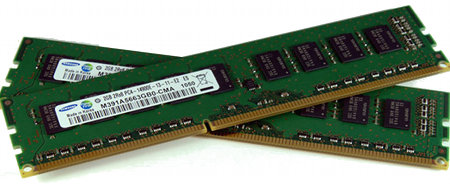Samsung spins DDR4 memory
Jan 4, 2011 — by LinuxDevices Staff — from the LinuxDevices Archive — 4 viewsSamsung Electronics announced what it says is the industry's first DDR4 memory module, using 30nm process technology. DDR4 will reduce power consumption by 40 percent and increase access speeds by about 30 percent compared to DDR3, the company says.
According to Samsung, its DDR4 memory module uses "a new circuit architecture" and POD (pseudo open drain), a technology that permits it to consume half the electric current of DDR3 when reading and writing data. When applied to a notebook computer, a typical 1.2V DDR4 module will reduce power consumption by 40 percent compared to a 1.5V DDR3 module, the company adds.
Regarding data transfer, Samsung says the DDR4 module can achieve data transfer rates of 2.133 Gbps at 1.2V, compared to equivalent 1.35V or 1.5V DDR3 DRAM, which runs at up to 1.6Gbps. Eventually, it's said, DDR4 will be able to reach speeds of 3.2Gbps.

Samsung's DDR4 memory
(Click to enlarge)
Samsung says it provided its 1.2V, 2GB DDR4 unbuffered dual in-line memory (UDIMM) modules to a controller maker for testing last month. In a next step, the company now plans "to work closely with a number of server makers to help insure completion of JEDEC [link] standardization of DDR4 technologies in the second half of this year."
Dong Soo Jun, president of the company's memory division, stated, "Samsung has been coming up with eco-friendly, innovative memory products providing higher performance and power efficiency every year. The new DDR4 DRAM will build even greater confidence in our cutting-edge green memory, particularly when we introduce 4GB DDR4-based products using next generation process technology for mainstream applications."
According to Samsung, it developed the industry's first DDR DRAM in 1997, introduced the first DDR2 DRAM in 1997, and announced the first DDR3 DRAM using 80nm-class technology in 2005.
This article was originally published on LinuxDevices.com and has been donated to the open source community by QuinStreet Inc. Please visit LinuxToday.com for up-to-date news and articles about Linux and open source.